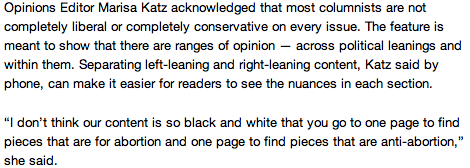By Andrew Gibson

The debate will never end.
Many say mainstream media are liberal. CNN faced criticism for being too friendly to now-President Barack Obama during his presidential campaign.
But others fire back, saying the media lean right. Watch Fox News, they say.
The Washington Post has a completely different take on this dispute. It goes like this: Why let people speculate?
A July 11 Poynter article spotlights the Post’s strategy of explicitly identifying whether its columns are liberal or conservative. The policy has faced some criticism, according to author Mallary Jean Tenore in the story:
 But Tenore also cites a Washington Post conservative blogger who says labeling the left and right is an example of transparency.
But Tenore also cites a Washington Post conservative blogger who says labeling the left and right is an example of transparency.Also from the article:
 The website also has a main political opinions page that features the more centrist columns, according to the article.
The website also has a main political opinions page that features the more centrist columns, according to the article.But the Post is just one of many outlets that report on the government. Here’s a look at how another newspaper, a niche publication and two TV networks show — or hide — contributor opinions.
(1) The New York Times
The New York Times target = "new" doesn’t identify where its political contributors lie on the spectrum. Online visitors can click to see background information about the columnists, but it’s biographical, not ideological.
Contributors to Room for Debate target = "new" , a blog in which multiple outsiders respond to a single question, do sometimes openly identify with a political party. Rep. Patrick McHenry, R-N.C., was one of the participants in a debate about mortgage relief.
 However, the topics are not always political. One was “Why Did Wild Nail Polish Go Mainstream?“
However, the topics are not always political. One was “Why Did Wild Nail Polish Go Mainstream?“Like the Post, The New York Times separates op-ed pieces from columns.
(2) Politico
Politico has a surprisingly simple opinion page for being a niche political website.
The page doesn’t identify its contributors’ ideologies, but bylines that include “Rep.” or “Sen.” make finding out their political stances less than challenging. A Google search is all it takes to find out what party they represent.
Politico has an “About Us” section with biographies of almost all of its staffers. One missing is that of President and CEO Frederick J. Ryan Jr.
According to a Salon article, Ryan has a long history with the Republican Party, including serving as President Reagan’s assistant and making a $1,000 donation to former-President George W. Bush in 1999. Allbritton Co., Politico’s main funding source, also has “close ties” to a former right-wing Chilean dictator supported by the Reagan administration, according to the story.
Writer Glenn Greenwald thinks this could be reason for concern:
 While some might call The Washington Post’s left-right labeling polarizing, Politico visitors familiar with Ryan’s background might automatically assume columns have a conservative edge because the site doesn’t specify otherwise.
While some might call The Washington Post’s left-right labeling polarizing, Politico visitors familiar with Ryan’s background might automatically assume columns have a conservative edge because the site doesn’t specify otherwise.(3) CNN
The Washington Post online strategy of labeling columns as left-leaning or right-leaning seems to be the exception, not the rule, because CNN doesn’t do it either.
However, contributor biographies on the site sometimes point out partisan leanings. Here’s one that precedes the opinion piece “How Obama should talk about the economy“:
 The opinion page has an “Editor’s choice” section that’s a bit of a mystery. It’s unclear who picks the stories that appear here and whether that person judges them based on personal views or journalistic merit.
The opinion page has an “Editor’s choice” section that’s a bit of a mystery. It’s unclear who picks the stories that appear here and whether that person judges them based on personal views or journalistic merit.(4) Fox News
Unlike The New York Times and CNN, Fox News doesn’t have a link to its opinion section in the main body of the political home page. Visitors have to use the top navigation bar.
The site doesn’t openly label its online opinion writers as liberals or conservatives, either In fact, contributor biographies aren’t included at all.
But Fox News Chairman Roger Ailes has a history as a Republican strategist, meaning that similar to Politico, website visitors might assume opinion pieces lean conservative.
So, The Washington Post is unique. Who cares?
That depends on whom you ask.
A Google search will likely reveal a columnist’s political history if a news website doesn’t. Looked at that way, the Post’s transparency-first strategy may seem un-necessary.
But it’s also innovative in its own right. Ideological labeling is an experiment in both business and journalism, according to Fred Hiatt, the Washington Post editorial page editor, in the Poynter story:
And debate, of course.



No comments:
Post a Comment